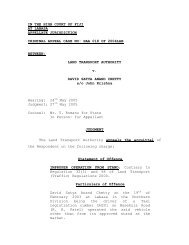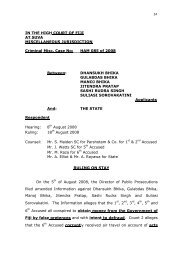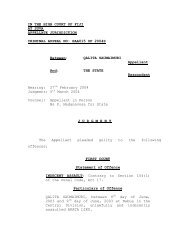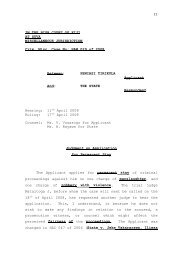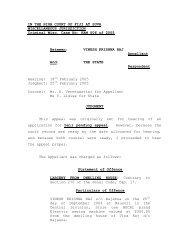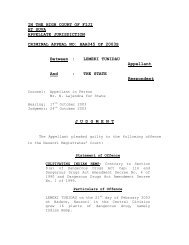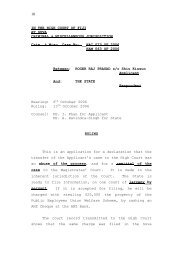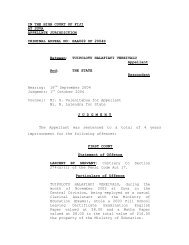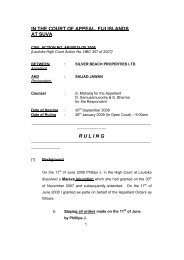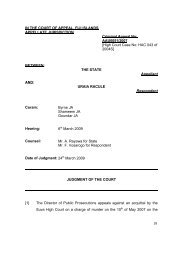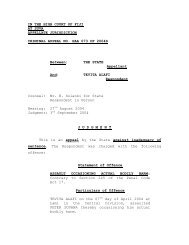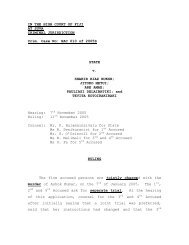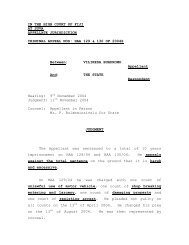Download LTA v Patrick Singh Judgements - Law Fiji
Download LTA v Patrick Singh Judgements - Law Fiji
Download LTA v Patrick Singh Judgements - Law Fiji
Create successful ePaper yourself
Turn your PDF publications into a flip-book with our unique Google optimized e-Paper software.
IN THE HIGH COURT OF FIJI<br />
AT SUVA<br />
APPELLATE JURISDICTION<br />
CRIMINAL APPEAL NO: HAA 005 OF 2004S<br />
Between:<br />
LAND TRANSPORT AUTHORITY<br />
Appellant<br />
And:<br />
PATRICK SINGH<br />
Respondent<br />
Hearing: 2 nd April 2004<br />
Judgment: 8 th April 2004<br />
Mr. V. Vosarogo for <strong>LTA</strong><br />
Respondent in Person<br />
JUDGMENT<br />
This is an appeal by the Land Transport Authority<br />
against the acquittal of the Respondent on the following<br />
charge:<br />
Statement of Offence<br />
DANGEROUS FITTING: Contrary to Regulation 43<br />
(1) (a) and 122 of Land Transport (Vehicle<br />
Registration and Construction) Regulations<br />
2000.<br />
Particulars of Offence<br />
PATRICK SINGH s/o JAMES SHANKAR SINGH on the<br />
30 th of August 2001 at Suva in the Central<br />
Division drove a motor vehicle (private) on<br />
Grantham Road (Rups) with dangerously fitted<br />
bull bar, which was likely to cause bodily<br />
injury to any person or damage to another<br />
vehicle or property in collision.
2<br />
The Respondent pleaded not guilty to the charge and<br />
the case was set for hearing on the 21 st of November 2003.<br />
The evidence was that in 2000 and 2001, members of the<br />
public who had “bull bars” attached to their vehicles, were<br />
told to come to the Land Transport Authority to apply for<br />
approval. Bull bars are mechanical or body parts which are<br />
fitted onto the vehicle as an option.<br />
On the 22 nd of August 2001, Deve Moca, an <strong>LTA</strong><br />
authorised officer was on duty at Grantham Road, when he<br />
saw DJ173, the Respondent’s vehicle. His companion, also<br />
an <strong>LTA</strong> Officer stopped the vehicle and asked the Respondent<br />
if he had approval to have the bull bars. He said he had<br />
none. He was issued with a Traffic Infringement Notice and<br />
was warned for prosecution. The witness then said “that<br />
same vehicle with same bull bars is still dangerous today<br />
to other persons and vehicles but it is legal because of<br />
the permit from <strong>LTA</strong>.”<br />
Mohammed Hussein (PW3) said he had issued a defects<br />
notice to the Respondent because the vehicle was dangerous.<br />
However the vehicle was no longer dangerous because the<br />
Respondent had paid $74 and had been issued with a permit<br />
to drive with the bull bars.<br />
PW4, Teresia Losalini Rasei, a vehicle examiner, said<br />
that she had inspected the vehicle on the 30 th of August<br />
2001. She had checked the bull bars and found them to be<br />
within the legal limits. She then issued an approval<br />
notice for the bull bars.
3<br />
On the 22 nd of December 2003, the learned Magistrate<br />
ruled that there was no case for the Respondent to answer.<br />
He said:<br />
“What actually surprised the Court was that<br />
this T3 bull bars are still classified as<br />
dangerous fittings likely to cause bodily<br />
injuries to any person or damage to another<br />
vehicle or property in collision; and without<br />
any modification to make it safer, can be made<br />
legal with the payment of $74.00 and a permit<br />
issued by the Land Transport Authority. This<br />
is really absurd.”<br />
He held that if the bull bars were dangerous, then<br />
they should not be approved after payment of a fee, and<br />
that therefore there was no case to answer.<br />
The Authority appeals against this finding.<br />
grounds of appeal are:<br />
The<br />
“(a) Erred in law and in fact when it<br />
accepted that the bull bar fitted to<br />
the respondent’s vehicle was a type<br />
that was approved by the appellant.<br />
(b)<br />
(c)<br />
(d)<br />
Erred in law and in fact in its finding<br />
that all witnesses were aware that it<br />
was an approved type.<br />
Was wrong in law when it misapplied the<br />
regulations applicable to the fitting<br />
of accessories to vehicles.<br />
Misdirected himself in law in finding<br />
that there was no case to answer for<br />
the respondent.”
4<br />
In his submissions in court, counsel for the Authority<br />
said that the offence was a strict liability offence, and<br />
that the learned Magistrate erred in holding that the<br />
danger alleged had been removed by the issuing of a permit.<br />
He submitted that Regulation 43(2) provided that the<br />
Authority could approve bull bars which are technically<br />
essential to the use of the vehicle. He further submitted<br />
that Regulation 43 was aimed at those who drove with bull<br />
bars without approval, and the purpose of the Regulation<br />
was the protection of the public from potentially dangerous<br />
bull bars. He asked that I substitute a finding that there<br />
was a case to answer.<br />
The Respondent said that the only question for the<br />
Magistrate was whether the bull bars were dangerous. He<br />
said that the fact that the Authority now allowed him to<br />
keep the bull bars without modification suggests that they<br />
were not, and are not, dangerous.<br />
Regulation 43(1)(a) of the Land Transport (Vehicle<br />
Registration and Construction) Regulations 2000 provides<br />
that no motor vehicle may be fitted with an object<br />
protruding from the vehicle so that it is likely to cause<br />
bodily injury to any person or damage to another vehicle in<br />
collision. Regulation 43 also provides that the Authority<br />
may authorise fittings which are technically essential to<br />
the vehicle. There is no reference to the word “dangerous”<br />
in the section although the heading reads “Dangerous<br />
Fittings.”<br />
The elements of the offence are:
5<br />
1. The accused’s motor vehicle;<br />
2. Was fitted with;<br />
3. An object which protruded from the vehicle;<br />
4. Which was likely to increase the risk of<br />
bodily injury or damage to another vehicle.<br />
There was no dispute that the Respondent drove DJ173.<br />
Nor is it in dispute that it was fitted with a bull bar not<br />
technically essential to the vehicle. The only matter in<br />
dispute was whether the bars were likely to cause injury or<br />
damage in a collision. What was the evidence that the bars<br />
were dangerously fitted? The vehicle examiner, PW4 said<br />
that the bars were “within the legal limits.” Mohammed<br />
Hussein PW3 said he issued a defects notice on the basis<br />
that the vehicle was dangerous on 30 th August, “but not now<br />
after accused has paid $74 and was given permit by <strong>LTA</strong>.”<br />
What is likely to cause damage and injury in a<br />
collision must surely be a question of fact, based on<br />
evidence led. The test is an objective one. Someone<br />
should have given evidence of the damage that was likely to<br />
be caused by the bull bars on the Respondent’s car. But<br />
there was no such evidence. Instead the Authority later<br />
allowed the Respondent to keep the bars. Surely if the<br />
bars were potentially dangerous, approval would never have<br />
been given. There was no evidence at all that the bull<br />
bars, objectively speaking, would be dangerous to the<br />
public in a collision. Instead, the evidence suggested<br />
otherwise.<br />
I am not persuaded by counsel’s submission that the<br />
Regulation should be read as a prohibition on the use of<br />
unapproved bull bars. The words of the Regulation are
6<br />
clear, precise and unambiguous. The prohibition is in<br />
relation to potentially dangerous fittings, and the onus is<br />
on the prosecution to prove potential danger. It will be<br />
necessary to call evidence as to the danger posed by those<br />
bull bars. The issuing of permits in relation to the bull<br />
bars is of limited importance except to show that the<br />
Authority itself may not consider the bars dangerous and<br />
that they are technically essential to the vehicle.<br />
However, even the issuing of a permit will not rob a<br />
dangerous fitting of its dangerous qualities, if the court<br />
has decided that those fittings are dangerous. A permit<br />
may however deprive the prosecution of the ability to prove<br />
that the bull bars were not technically essential, since a<br />
permit can only be granted under Reg. 43(2) when the<br />
fittings are technically essential.<br />
In this case there was no evidence led of potential<br />
danger an essential element of the offence. The learned<br />
Magistrate rightly upheld the submission of no case to<br />
answer.<br />
This appeal is dismissed.<br />
…………………………………………………………<br />
Nazhat Shameem<br />
JUDGE<br />
At Suva<br />
8 th April 2004



